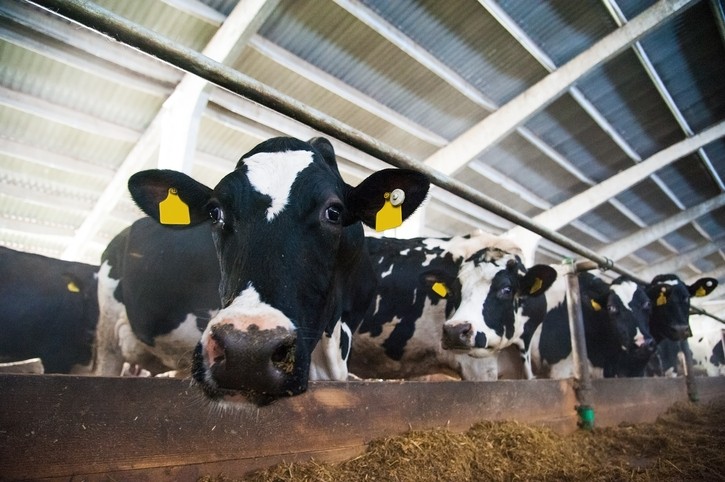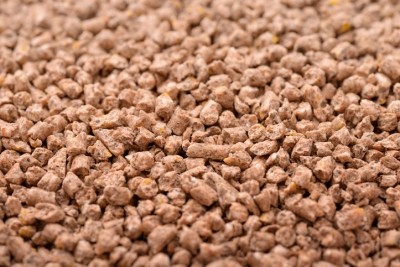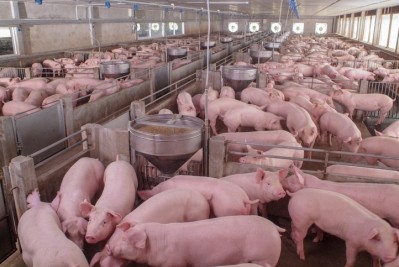Novel oilseed by-product may boost protein in dairy cattle diets

An international team based in Canada and China explored the use of pelleted feeds combining new and known feed ingredients and additives on energy use and digestion in dairy cows.
The group published its work in the journal of Animal Feed Science and Technology.
“The present study was conducted to develop and test eight blend pelleted products based on the combination of the new co-product from biofuel processing of carinata seed, conventional co-product from bio-oil processing of canola seed, pea screenings and lignosulfonate at different levels for ruminants in terms of rumen degradation kinetics, intestinal digestibility and nitrogen to energy synchronization in order to efficiently utilize the new co-product and optimize nutrient supply in dairy cows,” they said.
“Comparisons were made between blend pelleted products based on carinata meal and canola meal, low and high level of inclusion of co-product as well as inclusion and no inclusion of lignosulfonate.“
The mixed pellets including carinata (CR) generated higher levels of rumen undegraded protein, more effective degradation of neutral detergent fiber (NDF), improved intestinal absorption of feed protein and more digestible protein, the researchers said.
“The new co-product (carinata meal) based pelleted products can provide higher amounts of rumen bypass protein, intestinal absorbable feed protein and total digested protein as well as total digestible fiber than the conventional co-product (canola meal) based blend pelleted products,” they added.
“Therefore, the result of this study suggest that the carinata meal based pelleted products [like diets] BPP3 and BPP4, can be used as high-quality protein supplements for dairy cows,” they concluded.
Why carinata and pea feeds?
Dairy cows need adequate amounts of amino acids and glucose to maintain high milk production. To meet that need, dairy cow diets need to include enough nitrogen (N) for microbial protein synthesis in the rumen along with adequate amounts of digestible dietary bypass protein and non-structural carbohydrates, wrote the authors of the study.
In North America, one common protein supplement is the conventional co-product canola meal, they said. Additionally, the use of pea screenings – a co-product from the pulse processing industry – are gaining attention for use in dairy cattle diets.
Carinata meal is a relatively new biofuel co-product, but its nutritional value is yet to be fully understood, said the researchers. Previous work exploring the benefits of the meal showed it had a high degradation rate, with protein amounts similar to canola seed although more effectively degraded organic matter and crude protein.
“The rapid feed rumen degradation can be reduced through addition of lignosulfonate; and application of suitable pelleting processing method,” the researchers said. “Moreover, pelleting process improves the degradation of resistant starch in rumen by 15% and also greatly improve rumen crude protein (CP) degradation in dairy cows.”
It is necessary to understand how rumen degradation kinetics and intestinal digestion are altered by pelleting and use of lignosulfonate when evaluating a blend pelleted product (BPP) incorporating carinata meal, canola meal or pea screenings for use as a feed, they said.
“There is little information available on rumen degradation kinetics, intestinal digestibility as well as nitrogen to energy synchronization, especially when this new carinata meal is blended with other feedstuffs as a pellet,” they said.
Methods and materials
In the evaluation, four rumen-cannulated cows were used to evaluate eight trial diets, the researchers said.
The team compared the use of the novel co-product carinata meal and the conventional co-product canola meal along with the use of pea screenings and lignosulfonate.
Cows were given a total mixed ration that used “218 g/kg of barley silage, 157 g/kg of corn silage, 139 g/kg cut alfalfa, 28 g/kg canola meal, 331 g/kg of concentrate, 20 g/kg of barley grain, 102 g/kg of pulp pellets and 5 g/kg of palmitic acid,” they said. Average daily feed intake was 28kg of dry matter (DM).
The blend pelleted diets incorporating the trial protein meal included “BPP1: lignosulfonate 0.0% + carinata meal 50.0% + pea screenings 50.0%; BPP2: lignosulfonate 4.8% + carinata meal 47.6% + pea screenings 47.6%; BPP3: lignosulfonate 0.0% + carinata meal 75.0% + pea screenings 25.0%; and BPP4: lignosulfonate 4.8% + carinata meal 71.4% + pea screenings 23.8%,” they said. The comparison diets using canola meal were “BPP5: lignosulfonate 0.0% + canola meal 50.0% + pea screenings 50.0%; BPP6: lignosulfonate 4.8% + canola meal 47.6% + pea screenings 47.6%; BPP7: lignosulfonate 0.0% + canola meal 75.0% + pea screenings 25.0%; and BPP8: lignosulfonate 4.8% + canola meal 71.4% + pea screenings 23.8%.”
About 7g DM of a trial pellet was bagged and incubated in the cows’ rumens for 0, 2, 4, 8, 12, 24 and 48 hours, the researchers said.
The sampled feeds and residues were then analyzed for crude protein (CP), neutral detergent fiber (NDF), starch (ST), degradation characteristics of DM, CP, NDF and ST and the hourly effective rumen degradation ratios and potential N-to energy synchronization was calculated.
An estimation of intestinal digestion also was made, they said.
Results
The rate of degradation (Kd) of DM changed among the diets and the highest value was found for BPP6, while diets with higher levels of pea screenings – BPP1, BPP2, BPP5 and BPP6 – had higher degradation values, the researchers said. However, the undegradable fraction, soluble fraction and degradable fraction were similar among all the diets.
“Carinata-based blend pelleted products BPP3 and BPP4 in which the level of inclusion of CR was higher than the other two carinata blend pelleted products BPP1 and BPP2 had higher %BDM [rumen bypass or undegraded feed dry matter] than the other blend pelleted products,” they said. Carinata-based diets also had more rumen bypass dry matter than the canola diets.
Diets with larger amounts of pea screenings had a higher percentage of effective degraded dry matter (EDDM) and adding more pea screenings or less co-product boosted the rate of degradation, they said. Lignosulfonate had little effect.
“The BPP3 and BBP4 containing the higher levels of carinata meal provided higher rumen bypass protein, intestinal absorbable feed protein and higher total digested NDF than the other blend pelleted products, which can potentially be used as high-quality protein supplements for dairy cows,” they said.
There were several differences in the degradation kinetics of CP among the diets, with canola-based pellets displaying a higher degradation rate of CP and a larger soluble fraction of CP than carinata-based pellets, said the researchers.
“The carinata based BPP contained lower degradation rate, lower soluble and potential degradation fraction, but higher undegraded fraction, lower rumen effective degraded protein and higher rumen bypass protein than canola-based BPP,” they said.
Canola-based pellets had higher rates of degradation for NDF, they said. However, carinata diets had a more degradable fraction of NDF and the rumen undegradable neural detergent fiber value was higher for canola than carinata.
The rumen undegradable starch values were lower for diets that included higher levels of either protein meal, they said. The intestinal digestibility of DM was higher in carinata-based pellets than for those including canola.
Source: Animal Feed Science and Technology
DOI: doi.org/10.1016/j.anifeedsci.2017.11.011
Title: Potential nitrogen to energy synchronization, rumen degradation kinetics, and intestinal digestibility of blend pelleted products of new co-products from bio-fuel processing, pulse screenings and lignosulfonate compound in dairy cows
Authors: V G Oquendo, D Christensen, J McKinnon, M D Rahman, P Yu















